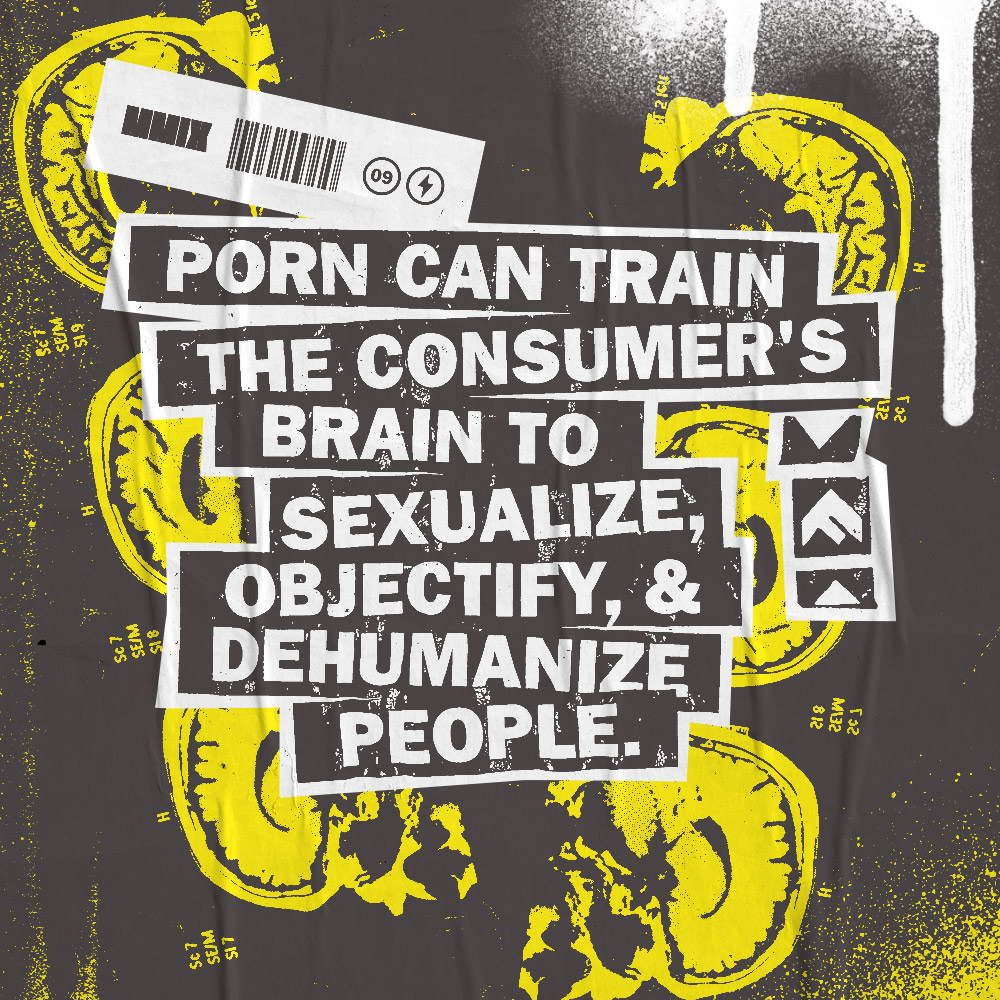4 minute read.
A pornography epidemic is on the rise, not only because it is easier to access, but because of the lack of information people have had on the negative and harmful effects associated with this harmful, depressive material. In this case, ignorance really isn’t bliss.
From a business perspective, the porn industry has a pretty clever racket going. Their product offers consumers temporary relief from anxiety, depression, and loneliness in exchange for making these same problems much worse in the long-term. [1] That works out really well for pornographers, since the worse their customers’ anxiety and isolation grow, the more reason they have to turn back to porn. But for the consumer, the end result isn’t nearly so nice.
“Any time [a person] spends much time with the usual pornography usage cycle, it can’t help but be a depressing, demeaning, self-loathing kind of experience,” says Dr. Gary Brooks, a psychologist who has worked with porn addicts for the last 30 years. [2]
Fueling isolation and loneliness
The more pornography a person consumes, the more their brain connects being aroused with porn’s fictional fantasy [3]—and the harder it becomes for them to be aroused by a real person or a real relationship. [4]
As a result, many consumers start feeling like something’s wrong with them; they don’t know how to be turned on by a real person, much less form a deep personal connection with one. [5]
Related: Four Ways Watching Porn Can Disconnect You From Reality
Naomi Wolf, author and political activist, has traveled all over the country to talk with college students about relationships. “When I ask about loneliness, a deep, sad silence descends on audiences of young men and young women alike,” she says. “They know they are lonely together … and that [porn] is a big part of that loneliness. What they don’t know is how to get out.” [6]
A steadily escalating pattern of depression
Studies have found that when people engage in an ongoing pattern of “self-concealment”—which is when they do things they’re not proud of and keep them a secret from their friends and family members—it not only hurts their relationships and leaves them feeling lonely, but also makes them more vulnerable to severe psychological problems. [7] For both male and female porn consumers, their habit is often accompanied by problems with anxiety, body-image issues, poor self-image, relationship problems, insecurity, and depression. [8]
Related: True Story: My Depression Disappeared When I Stopped Watching Porn
We do know that pornography and other addictions or compulsions are used as self-medicating tools, which can lead to depression. More research is being conducted and more evidence is arising to show the damaging effects pornography and other sexual addictions have on our brains, body, relationships, and life.
It is hard to say what comes first, the pornography addiction or depression.
However, pornography and other addictions are used to make the consumer (temporarily) forget about feelings of sadness, fear, anger, or boredom. This habit can quickly lead to depression and is also something depression can lead to. It’s like a chicken and egg scenario: you’re not really sure which one comes first, but in this case you sure don’t want to find out because it can very quickly affect your mental health.
One negative aspect of what porn teaches consumers is that both men and women aren’t worth anything more than the sum of their body parts and how much sexual pleasure they can offer. [9] Whether porn consumers like it or not, those perceptions often start creeping into how they see themselves and other people in real life. [10] The more difficult it becomes for the consumer to see themselves and others as anything more than sexual objects, the harder it is to develop real relationships. [11]
Related: Watching Porn Killed My Self-Confidence And Made Me Hate My Body
“There’s a certain way of experiencing sexual arousal that is the opposite of closeness,” Brooks said. “At best, it can be managed somewhat by some people, but most of the time it creates a barrier that poisons relationships.” [12]
Why this matters
The porn industry offers its content as a solution to rejection, failed relationships, and loneliness. They present tantalizing imagery and promise that consumers will be satisfied and soothed. Many consumers buy into the lies, and they enter a twisted fantasy world that can be difficult to escape.
What begins as a form of self-medication can escalate into a vicious cycle of depression, relapse, and self-hatred. The worst part is that as a consumer numbs them self with graphic sexual images and videos, they are missing out on building some real, amazing relationships with their partner, friends, and community. In the end, no amount of pornography will take away anyone’s real-life problems. In fact, it will just become one of them.
This is why we fight for love and spread the word about the harmful effects of pornography. The research is clear on the matter, and it’s time for society to listen.
Are you with us?
Need help?
For those reading this who feel they are struggling with pornography, you are not alone. Check out Fortify, a science-based recovery platform dedicated to helping you find lasting freedom from pornography. Fortify now offers a free experience for both teens and adults. Connect with others, learn about your unwanted porn habit, and track your recovery journey. There is hope—sign up today.
Fight the New Drug may receive financial support from purchases made using affiliate links.

Citations
[1] Flisher, C. (2010). Getting Plugged In: An Overview of Internet Addiction. Journal of Paediatrics and Child Health 46: 557–9; Layden, M. A. (2010). Pornography and Violence: A New look at the Research. In J. Stoner and D. Hughes (Eds.) The Social Costs of Pornography: A Collection of Papers (pp. 57–68). Princeton, NJ: Witherspoon Institute; Paul, P. (2007). Pornified: How Pornography Is Transforming Our Lives, Our Relationships, and Our Families. New York: Henry Hold and Co., 82; Kafka, M. P. (2000). The Paraphilia-Related Disorders: Nonparaphilic Hypersexuality and Sexual Compulsivity/Addiction. In S. R. Leiblum and R. C. Rosen (Eds.) Principles and Practice of Sex Therapy, 3rd Ed. (pp. 471–503). New York: Guilford Press.
[2] Interview with Dr. Gary Brooks, Oct. 23, 2013.
[3] Paul, P. (2007). Pornified: How Pornography Is Transforming Our Lives, Our Relationships, and Our Families. New York: Henry Hold and Co., 105.
[4] Paul, P. (2007). Pornified: How Pornography Is Transforming Our Lives, Our Relationships, and Our Families. New York: Henry Hold and Co., 105; Doidge, N. (2007). The Brain That Changes Itself. New York: Penguin Books, 104.
[5] Interview with Dr. Gary Brooks, Oct. 23, 2013; Paul, P. (2007). Pornified: How Pornography Is Transforming Our Lives, Our Relationships, and Our Families. New York: Henry Hold and Co., 105.
[6] Wolf, N. (2004). The Porn Myth. New York Magazine, May 24.
[7] Laird, R. D., Marrero, M. D., Melching, J. A., and Kuhn, E. S. (2013). Information Management Strategies in Early Adolescence: Developmental Change in Use and Transactional Associations with Psychological Adjustment. Developmental Psychology 49, 5: 928–937; Luoma, J. B., Nobles, R. H., Drake, C. E., Hayes, S. C., O’Hair, A., Fletcher, L., and Kohlenberg, B. S. (2013). Self-Stigma in Substance Abuse: Development of a New Measure. Journal of Psychopathology and Behavioral Assessment 35: 223–234; Rotenberg, K. J., Bharathi, C., Davies, H., and Finch, T. (2013). Bulimic Symptoms and the Social Withdrawal Syndrome. Eating Behaviors 14: 281–284; Frijns, T. and Finkenauer, C. (2009). Longitudinal Associations Between Keeping a Secret and Psychosocial Adjustment in Adolescence. International Journal of Behavioral Development 33, 2: 145–154.
[8] Flisher, C. (2010). Getting Plugged In: An Overview of Internet Addiction. Journal of Paediatrics and Child Health 46: 557–9; Layden, M. A. (2010). Pornography and Violence: A New look at the Research. In J. Stoner and D. Hughes (Eds.) The Social Costs of Pornography: A Collection of Papers (pp. 57–68). Princeton, NJ: Witherspoon Institute; Kafka, M. P. (2000). The Paraphilia-Related Disorders: Nonparaphilic Hypersexuality and Sexual Compulsivity/Addiction. In S. R. Leiblum and R. C. Rosen (Eds.) Principles and Practice of Sex Therapy, 3rd Ed. (pp. 471–503). New York: Guilford Press.
[9] Paul, P. (2007). Pornified: How Pornography Is Transforming Our Lives, Our Relationships, and Our Families. New York: Henry Hold and Co., 80; Mosher, D. L. and MacIan, P. (1994). College Men and Women Respond to X-Rated Videos Intended for Male or Female Audiences: Gender and Sexual Scripts. Journal of Sex Research 31, 2: 99–112.
[10] Interview with Dr. Gary Brooks, Oct. 23, 2013.
[11] Paul, P. (2007). Pornified: How Pornography Is Transforming Our Lives, Our Relationships, and Our Families. New York: Henry Hold and Co., 79; Lyons, J. S., Anderson, R. L., and Larsen, D. (1993). A Systematic Review of the Effects of Aggressive and Nonaggressive Pornography. In D. Zillmann, J. Bryand, and A. C. Huston (Eds.) Media, Children and the Family: Social Scientific, Psychodynamic, and Clinical Perspectives (p. 305). Hillsdale, N.J.: Erlbaum Associates.
[12] Interview with Dr. Gary Brooks, Oct. 23, 2013.
Your Support Matters Now More Than Ever
Most kids today are exposed to porn by the age of 12. By the time they’re teenagers, 75% of boys and 70% of girls have already viewed itRobb, M.B., & Mann, S. (2023). Teens and pornography. San Francisco, CA: Common Sense.Copy —often before they’ve had a single healthy conversation about it.
Even more concerning: over half of boys and nearly 40% of girls believe porn is a realistic depiction of sexMartellozzo, E., Monaghan, A., Adler, J. R., Davidson, J., Leyva, R., & Horvath, M. A. H. (2016). “I wasn’t sure it was normal to watch it”: A quantitative and qualitative examination of the impact of online pornography on the values, attitudes, beliefs and behaviours of children and young people. Middlesex University, NSPCC, & Office of the Children’s Commissioner.Copy . And among teens who have seen porn, more than 79% of teens use it to learn how to have sexRobb, M.B., & Mann, S. (2023). Teens and pornography. San Francisco, CA: Common Sense.Copy . That means millions of young people are getting sex ed from violent, degrading content, which becomes their baseline understanding of intimacy. Out of the most popular porn, 33%-88% of videos contain physical aggression and nonconsensual violence-related themesFritz, N., Malic, V., Paul, B., & Zhou, Y. (2020). A descriptive analysis of the types, targets, and relative frequency of aggression in mainstream pornography. Archives of Sexual Behavior, 49(8), 3041-3053. doi:10.1007/s10508-020-01773-0Copy Bridges et al., 2010, “Aggression and Sexual Behavior in Best-Selling Pornography Videos: A Content Analysis,” Violence Against Women.Copy .
From increasing rates of loneliness, depression, and self-doubt, to distorted views of sex, reduced relationship satisfaction, and riskier sexual behavior among teens, porn is impacting individuals, relationships, and society worldwideFight the New Drug. (2024, May). Get the Facts (Series of web articles). Fight the New Drug.Copy .
This is why Fight the New Drug exists—but we can’t do it without you.
Your donation directly fuels the creation of new educational resources, including our awareness-raising videos, podcasts, research-driven articles, engaging school presentations, and digital tools that reach youth where they are: online and in school. It equips individuals, parents, educators, and youth with trustworthy resources to start the conversation.
Will you join us? We’re grateful for whatever you can give—but a recurring donation makes the biggest difference. Every dollar directly supports our vital work, and every individual we reach decreases sexual exploitation. Let’s fight for real love:




